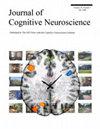词块持续时间限制了多词块的学习:来自统计学习的行为和脑电图证据
IF 3.1
3区 医学
Q2 NEUROSCIENCES
引用次数: 0
摘要
语言理解涉及将单词组合成更大的多词块。这就需要将信息重新编码成较稀疏的表征,以减轻记忆的局限性并抵消遗忘。有人认为,电生理处理时间窗口制约了这些单元的形成。具体来说,有节奏的神经活动(即慢频神经振荡)的周期可能会设定一个 2-3 秒的上限。在此,我们将评估新的多词块的学习是否也会受到这一神经限制的影响。我们采用了一种人工语言的听觉统计学习范式,同时操纵待学习词块的持续时间。受试者聆听双音节假词的等时序列,并根据过渡概率从中学习隐藏的三词组。我们通过改变伪词之间的停顿间隔,分别呈现了 1.95 秒、2.55 秒和 3.15 秒的词块。在第一个行为实验中,我们使用内隐目标检测任务测试了学习效果。我们发现,与更长的时间相比,2.55 秒的词块学习效果更好,这也符合我们提出的时间限制上限。在第二个实验中,我们记录了参与者在暴露阶段的脑电图,将频率标记作为统计学习的神经指标。结果表明,与较短的时间相比,超过 3 秒的语块的神经跟踪能力显著下降。总之,我们认为语言学习受到内源性时间限制的制约,这可能反映了电生理处理窗口。本文章由计算机程序翻译,如有差异,请以英文原文为准。
Chunk Duration Limits the Learning of Multiword Chunks: Behavioral and Electroencephalography Evidence from Statistical Learning
Language comprehension involves the grouping of words into larger multiword chunks. This is required to recode information into sparser representations to mitigate memory limitations and counteract forgetting. It has been suggested that electrophysiological processing time windows constrain the formation of these units. Specifically, the period of rhythmic neural activity (i.e., low-frequency neural oscillations) may set an upper limit of 2–3 sec. Here, we assess whether learning of new multiword chunks is also affected by this neural limit. We applied an auditory statistical learning paradigm of an artificial language while manipulating the duration of to-be-learned chunks. Participants listened to isochronous sequences of disyllabic pseudowords from which they could learn hidden three-word chunks based on transitional probabilities. We presented chunks of 1.95, 2.55, and 3.15 sec that were created by varying the pause interval between pseudowords. In a first behavioral experiment, we tested learning using an implicit target detection task. We found better learning for chunks of 2.55 sec as compared to longer durations in line with an upper limit of the proposed time constraint. In a second experiment, we recorded participants' electroencephalogram during the exposure phase to use frequency tagging as a neural index of statistical learning. Extending the behavioral findings, results show a significant decline in neural tracking for chunks exceeding 3 sec as compared to both shorter durations. Overall, we suggest that language learning is constrained by endogenous time constraints, possibly reflecting electrophysiological processing windows.
求助全文
通过发布文献求助,成功后即可免费获取论文全文。
去求助
来源期刊
CiteScore
5.30
自引率
3.10%
发文量
151
审稿时长
3-8 weeks
期刊介绍:
Journal of Cognitive Neuroscience investigates brain–behavior interaction and promotes lively interchange among the mind sciences.

 求助内容:
求助内容: 应助结果提醒方式:
应助结果提醒方式:


